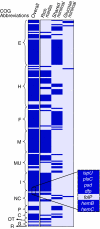A genome-scale metabolic reconstruction for Escherichia coli K-12 MG1655 that accounts for 1260 ORFs and thermodynamic information
- PMID: 17593909
- PMCID: PMC1911197
- DOI: 10.1038/msb4100155
A genome-scale metabolic reconstruction for Escherichia coli K-12 MG1655 that accounts for 1260 ORFs and thermodynamic information
Abstract
An updated genome-scale reconstruction of the metabolic network in Escherichia coli K-12 MG1655 is presented. This updated metabolic reconstruction includes: (1) an alignment with the latest genome annotation and the metabolic content of EcoCyc leading to the inclusion of the activities of 1260 ORFs, (2) characterization and quantification of the biomass components and maintenance requirements associated with growth of E. coli and (3) thermodynamic information for the included chemical reactions. The conversion of this metabolic network reconstruction into an in silico model is detailed. A new step in the metabolic reconstruction process, termed thermodynamic consistency analysis, is introduced, in which reactions were checked for consistency with thermodynamic reversibility estimates. Applications demonstrating the capabilities of the genome-scale metabolic model to predict high-throughput experimental growth and gene deletion phenotypic screens are presented. The increased scope and computational capability using this new reconstruction is expected to broaden the spectrum of both basic biology and applied systems biology studies of E. coli metabolism.
Figures





References
-
- (NC-IUBMB) NCotIUoBaMB (2006) Enzyme nomenclature. Moss, GP
-
- Albe KR, Butler MH, Wright BE (1990) Cellular concentrations of enzymes and their substrates. J Theor Biol 143: 163–195 - PubMed
-
- Alberty RA (2003) Thermodynamics of Biochemical Reactions. Massachusetts Institute of Technology: Cambridge, MA
-
- Alexander K, Young IG (1978) Alternative hydroxylases for the aerobic and anaerobic biosynthesis of ubiquinone in Escherichia coli. Biochemistry 17: 4750–4755 - PubMed
-
- Almaas E, Kovacs B, Vicsek T, Oltvai ZN, Barabasi AL (2004) Global organization of metabolic fluxes in the bacterium Escherichia coli. Nature 427: 839–843 - PubMed
Publication types
MeSH terms
Substances
Grants and funding
LinkOut - more resources
Full Text Sources
Other Literature Sources
Molecular Biology Databases

